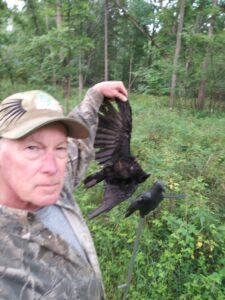Raining Crows
By Glen Wunderlich
Outdoor Columnist
Member Professional Outdoor Media Association
When Matt called me last week, it didn’t take much coaxing from him to get me to go crow hunting. After all, hunting nuts like us have sweltered through the summer heat longing for some action and nothing beats the frantic antics of the uncanny crow. Before we ended our conversation, we agreed to meet at Shawn’s house at 7 am and we’d head out from there.
Other crow excursions we’ve done have always been in the winter season, when hiding from air advances is almost impossible, unless one gets so buried in available cover that it’s actually difficult to get a shot off. Conversely, if one remains only partly hidden against the stark cover, he may be able to see quite well, but so do the airborne varmints.
In the August/September crow season, cover is everywhere. Camouflage clothing blends into the surroundings causing the keen eyesight of the black dive-bombers to be somewhat neutralized. It’s a huge advantage over crafty crow forays in the winter.
In addition, many of the birds have never been called or shot at, because they’re not old enough to remember the past seasons, having been born in the spring of the year. Too bad for them.
Shawn loaded his Browning Auto 5 with handloads comprised of 1 7/8 ounces of 9 shot – the loads we assembled last season. I had run out of the magnum loads from previous action and went with 1 1/8 ounce factory 8-shot loads in my Browning pump gun with a new Undertaker choke tube. Matt was using similar loads in his Remington.
Winter crow shoots typically relegate us to hiding behind tree trunks with very little canopy cover – not the best of circumstances. Of course, if we can find conifers in the area, it’s always a better choice in the winter, although, once again, sight lanes are quite restricted. The other challenge when hiding among the towering, bare deciduous branches is the height of the trees themselves. Getting crows to come in low enough for reasonable shots is almost impossible.
However, summer cover can be found among autumn olive shrubbery or small deciduous trees full of green foliage smack dab in the middle of fields far from sky-scraping trees. Our goal was to get them in for a close look at our flapping-wing decoys and to investigate the sounds of distress from their comrades.
The first productive set came at a familiar setting – one of Matt’s leased properties. We hung the motion decoys from low-hanging branches in the open and took cover in a triangular pattern with the setup as the center of attention. Unlike hunting four-legged animals on the ground, there was no danger of crossfire, since all shots are taken skyward.
Within seconds of the first fighting-crow screams from the FoxPro caller, black bandits homed in on the charade. I’ve never seen it rain cats and dogs, but I can tell you unequivocally that it began raining crows.
By noon the hunting clothes and boots became too much for the heat and humidity but we were able to connect on a much higher percentage of shots – apparently because of the strategy of hunting away from tall trees and our ability to blend in with nature.
The season runs to the end of September and, if your trigger finger could use a little exercise, and you can stand the heat, the summer crow season may be worth a try. Just watch out for falling crows!






